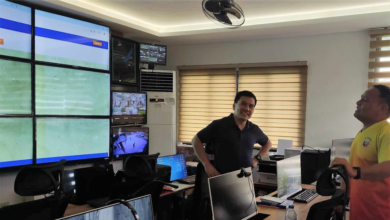Cloud technology revolutionising telecom – ET Edge Insights

Insights from AWS head of telecommunications
ETEDGE Insights had a conversation with Jayanth Nagarajan, the Head of Telecommunications Industry – Asia Pacific & Japan at AWS, to discuss cloud technology and its benefits in the telecommunications space.
Interview excerpts
1.Can you elaborate on cloud technology and its various technological benefits?
Over the last decade, cloud has redefined technological adoption and digitisation for businesses. Customers across every industry and of every size, including startups, enterprises, and public sector organisations, are running every imaginable use case on cloud now.
We have been continually expanding our services to support workloads growing in breadth, depth and complexity, and has now more than 240 fully featured services spanning compute, storage, databases, networking, analytics, machine learning, Internet of Things (IoT), mobile, security, hybrid, virtual and augmented reality (VR and AR), media, and application development, deployment, and management – supplemented and underpinned by AI. Some key benefits of using the cloud for telcos include the following:
- Simplifies operations, provides elasticity, and helps customers reduce total cost of ownership as well as energy consumption, all without sacrificing any control or ownership. In fact, a recent Omdia report found that telcos can save more than 10% in opex and capex by shifting operations to the cloud. Think of a Telco making ~$10B a year being able to save up to 10% with the cloud (that’s $1B going back to the bottom line). This makes a huge difference in the economics for Telcos. We are helping Telcos modernise their longstanding technology stacks along with our technology partners – these range from classic IT to customer-facing and enterprise applications, Network BSS & OSS systems, and now even Core and Radio networks, all underpinned by a scalable Data strategy.
- One of the most promising recent innovations in AI is the development of generative AI. Telcos are looking to AI/ML and generative AI to streamline costs, improve efficiencies, enable better customer engagement, and drive innovative new offerings. Enterprise-grade security and privacy, a choice of leading foundation models, a data-first approach, and the most performant, low-cost infrastructure are the key takeaways all telcos are looking at now.
- To continue delivering innovation at pace, telcos need a culture that is geared towards building. This requires leadership support to encourage new ways of thinking and a scale fast or fail fast mentality. And this is where upskilling across the business is crucial. Showcasing our commitment to skilling, we have trained over 5.5 million individuals in India with cloud skills since 2017.
- Energy Efficiency: The cloud’s scale and multi-tenancy allows us to offer an energy-efficient option for telcos to leverage for their own operations, contributing to their sustainability aims.. For example, in a recent trial, NTT Docomo tested the performance of 5G core hosting on our region and leveraged Graviton2 EC2 instances. NTT Docomo demonstrated an average of a 72% reduction in power consumption against x86-based instances .
2. Cloud and AI are intertwined – How can companies leverage this to provide the best services?
Artificial Intelligence (AI) and machine learning (ML) have been a focus for Amazon for more than 25 years, and many of the capabilities’ customers use with Amazon are driven by ML. Today, our ML models are working on behalf of hundreds of millions of customers around the world and providing tangible value by removing friction from supply chains, personalising digital experiences, and making goods and services more accessible and affordable.
For many telco customers, 2023 was a year of learning, experimentation, and PoCs. Generative AI will move from experimentation to real-world production over the next two years. Telcos can optimise their network services, reimagine the customer experience, and accelerate business performance. Additionally, Telcos can unlock generative AI’s predictive and prescriptive abilities to enhance network services by identifying potential connectivity issues before they arise, suggesting troubleshooting steps, and automating maintenance tasks.
We are focused on providing flexible approaches to meet telco companies’ needs – whether building their own foundation models (FMs) with purpose-built machine learning (ML) silicon infrastructure such as in-house Inferentia and Tranium chips; leveraging pre-trained foundation models available from Amazon (e.g.: Titan) as well as a wide variety of third parties (including Anthropic, Mistral, HuggingFace to name a few) to build their applications; or fine-tuning available models with additional data using services such as Amazon Bedrock and Amazon SageMaker Jumpstart. Additionally, they can use pre-built applications, such as Amazon CodeWhisperer, that use generative AI without requiring expertise in FMs or AI and ML technology.
For example, in India, L&T Technology Services is using Amazon CodeWhisperer to help engineers rapidly develop smart applications like driver warnings, automated braking, and steering functions for global automotive manufacturers accelerate the transition towards Software Defined Vehicles.
Across APJ, we have examples of Telcos using generative AI. For example, CelcomDigi, a Malaysian based communications conglomerate, announced a collaboration with us to co-create generative AI solutions using Amazon Bedrock to establish an AI Sandbox for its employees to experiment, innovate, and implement generative AI solutions. This includes potential use cases that will be integrated into CelcomDigi’s operational platforms for human resources, customer service, legal, finance, and more. Another example is Globe Telecom, the largest mobile operator in the Philippines, that needed a way to stabilise and improve customer retention. Globe had large volumes of internal data and wanted to analyse and leverage the data with more granularity for a competitive edge. To do so, they executed a proof of concept (PoC) with AWS and Stellar Elements, an Amdocs company. Globe tapped us for its Connected Customer Journey (CCJ) platform, part of our Solutions for Telecommunications product portfolio. CCJ can centralise and refine customer-context data from multiple channels. The AI-enabled PoC is structured around a robust data strategy, with Stellar Elements building data products on a data lake built on us. This is expected to provide capabilities such as real time churn prediction, real-time customer journey segmentation, next-best experience prediction, personalised communications and marketing, and human-like chatbots.
BT Group’s Digital Unit announced it deployed generative artificial intelligence (AI) coding companion Amazon CodeWhisperer , to provide coding assistance to its software engineers. The solution is already providing 15-20 suggestions of code per active user per day for BT Group, with an acceptance rate of 37% by its software engineers who are using the platform. Over 100,000 lines of code have been generated by Amazon CodeWhisperer in its first four months at BT Group—automating around 12% of the tedious, repetitive, and time-consuming work done by an initial group of volunteers. BT Group has now made the solution more widely available to 1,200 of its engineers across the business. This is particularly relevant to India – a country that has millions of developers, benefiting from the ability to do their jobs even more efficiently.
3.Tell us about your commitment to being a resilient technology provider across regions, and its impact.
Since 2010, we have invested tens of billions of US dollars into its world-class infrastructure across the Asia Pacific region and will continue our commitment to bring the benefits of cloud computing to more communities around the world. With millions of active customers and tens of thousands of partners globally, we are one of the world’s most comprehensive and broadly adopted cloud. We span 105 Availability Zones within 33 geographic regions, with announced plans for 18 more Availability Zones and six more Regions in Malaysia, Mexico, New Zealand, the Kingdom of Saudi Arabia, Thailand, and the European Sovereign Cloud.
In 2016, we launched the Asia Pacific (Mumbai) Region giving enterprises, public sector organisations, startups, and small and medium businesses (SMBs) access to state-of-the-art public cloud infrastructure. We currently operate two infrastructure regions in India: the Asia Pacific (Mumbai) Region, and the Asia Pacific (Hyderabad) Region opened in November 2022. The two regions are designed to provide Indian customers with multiple options to run workloads with even greater resilience and availability, securely store data in India, and serve end users with low latency. We have a long-term commitment to India, investing US$3.7 billion into the local cloud infrastructure from 2017 to 2022. In May 2023, we have announced plans to invest US$12.7 billion in India by 2030. This brings the company’s total investment in India to INR 1,36,500 crores (US $16.4 billion).
We are focused on empowering telecom companies on their digitisation journey. Telecom service providers have been able to bring in operational efficiency and deliver newer services faster. With significant spend on spectrum and subsequent 5G roll out, cloud adoption will help telcos to manage their spend with enhanced flexibility while matching with the uptake in demand. Bharti Airtel, among the leading telecom providers in India, and Apollo Hospitals, one of Asia’s foremost trusted integrated healthcare groups, carried out India’s first 5G-driven colonoscopy trials. The trial was conducted in collaboration with us using AI on Airtel’s 5G technology with ultra-low latency and high processing capabilities that resulted in detection of colon cancer much faster and with greater accuracy. We have collaborated with Airtel and Apollo hospitals to bring AI-powered solutions with an aim to improve patient experience and healthcare service quality.



